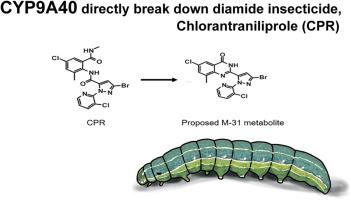对使 Spodoptera exigua 对二胺类杀虫剂产生抗性的解毒基因进行全基因组分析,发现了 CYP9A40。
IF 8.1
2区 环境科学与生态学
Q1 ENVIRONMENTAL SCIENCES
引用次数: 0
摘要
十多年来,二酰胺类杀虫剂一直对甜菜夜蛾等鳞翅目害虫有效。然而,抗药性的演变对其可持续使用构成了挑战。我们在 S. exigua 的雷诺丁受体(RyR)基因中发现了一个 I4790M 突变,但在田间采集的韩国 S. exigua 种群中,该突变与抗性的相关性各不相同。为了研究其他抗性机制,进行了 RNA 测序和差异基因表达分析。通过将 RNA-seq 读数映射到 S. exigua 参考基因组,对二胺抗性和易感株系及 F1 杂交种进行了比较。由于 CYP9A40 在抗性菌株中的高表达,它被确定为二酰胺抗性的关键基因。用胡椒基丁醚进行的增效剂生物测定证实了 P450s 在 S. exigua 的二酰胺代谢抗性中的作用。在田间采集的种群中,CYP9A40的过量表达水平(高达80倍)与二酰胺的半致死浓度值之间存在很强的正相关性,这些种群中RyR I4790M靶位抗性等位基因的频率均为100%。为了验证 CYP9A40 在二酰胺解毒中的功能,我们重组表达了该基因,并测试了其结合和降解作为底物的氯虫苯甲酰胺的能力。结果证实了它在二酰胺代谢中的催化作用。经鉴定和验证,CYP9A40 在韩国 S. exigua 群体中具有代谢抗性。它与 RyR 靶位点 I4790M 突变一起增强了二酰胺的抗性。这些机制为抗药性监测提供了启示,并支持杀虫剂抗药性管理计划,以改进对 S. exigua 的控制策略。本文章由计算机程序翻译,如有差异,请以英文原文为准。

Genome-wide analysis of detoxification genes conferring diamide insecticide resistance in Spodoptera exigua identifies CYP9A40
For over a decade, diamide insecticides have been effective against lepidopteran pests like beet armyworm, Spodoptera exigua (Hübner, 1808). However, the evolution of resistance poses a challenge to their sustainable use. We identified an I4790 M mutation in the S. exigua ryanodine receptor (RyR) gene, but its correlation with resistance varied across the field-collected Korean populations of S. exigua. RNA sequencing and differential gene expression analysis were performed to investigate other resistance mechanisms. Diamide-resistant and susceptible strains and F1 hybrids were compared by mapping RNA-seq reads to the S. exigua reference genome. CYP9A40 was identified as a critical gene in diamide resistance due to its high expression in the resistant strains. Synergist bioassays with piperonyl butoxide supported the role of P450s in diamide metabolic resistance in S. exigua. A strong positive correlation between CYP9A40 over-expression levels (up to 80-fold) and diamide LC50 values was obtained for field-collected populations uniformly showing a 100% frequency of the RyR I4790 M target-site resistance allele. To validate the function of CYP9A40 in diamide detoxification, we recombinantly expressed the gene and tested its ability to bind and degrade chlorantraniliprole as a substrate. The results confirmed its catalytic role in diamide metabolism. CYP9A40 has been identified and validated to confer metabolic resistance in Korean S. exigua populations. It works alongside the RyR target-site I4790 M mutation to enhance diamide resistance. These mechanisms offer insights for resistance monitoring and support insecticide resistance management programs to improve control strategies for S. exigua.
求助全文
通过发布文献求助,成功后即可免费获取论文全文。
去求助
来源期刊

Chemosphere
环境科学-环境科学
CiteScore
15.80
自引率
8.00%
发文量
4975
审稿时长
3.4 months
期刊介绍:
Chemosphere, being an international multidisciplinary journal, is dedicated to publishing original communications and review articles on chemicals in the environment. The scope covers a wide range of topics, including the identification, quantification, behavior, fate, toxicology, treatment, and remediation of chemicals in the bio-, hydro-, litho-, and atmosphere, ensuring the broad dissemination of research in this field.
 求助内容:
求助内容: 应助结果提醒方式:
应助结果提醒方式:


